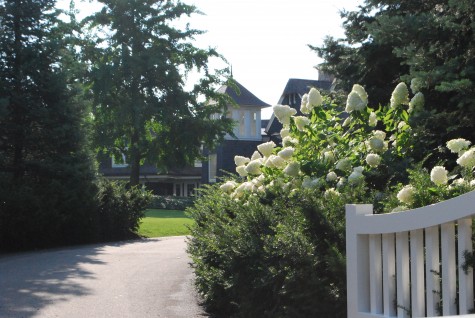 Every landscaped space has an entrance. That entrance may be physical, as in a path or stairs that lead the eye, and inspire the feet. Some entrances are strictly visual. A large open space without a visual cue about how to enter and where to go may seem muddled. A landscaped space running the depth of a property might have screening, or fencing on the long side, but there should be clues about where to enter, and where to exit. Some gardens have a gate at the entrance. Garden gates are beautiful, and functional. This gate spanning a driveway is one of a pair that when closed, says private. When they are open, they say welcome.
Every landscaped space has an entrance. That entrance may be physical, as in a path or stairs that lead the eye, and inspire the feet. Some entrances are strictly visual. A large open space without a visual cue about how to enter and where to go may seem muddled. A landscaped space running the depth of a property might have screening, or fencing on the long side, but there should be clues about where to enter, and where to exit. Some gardens have a gate at the entrance. Garden gates are beautiful, and functional. This gate spanning a driveway is one of a pair that when closed, says private. When they are open, they say welcome.
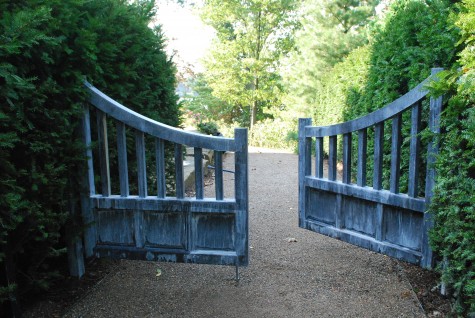 This decomposed granite walkway to the rear landscape is bisected by a pair of gates. The gate is a visual cue about a change of venue. In the time it takes to open the gate, and pass through, a visitor has paused, and is ready to move on. This gate does not particularly keep anyone or anything in or out. It is a beautiful opportunity to rest both visually and physically, before going on.
This decomposed granite walkway to the rear landscape is bisected by a pair of gates. The gate is a visual cue about a change of venue. In the time it takes to open the gate, and pass through, a visitor has paused, and is ready to move on. This gate does not particularly keep anyone or anything in or out. It is a beautiful opportunity to rest both visually and physically, before going on.
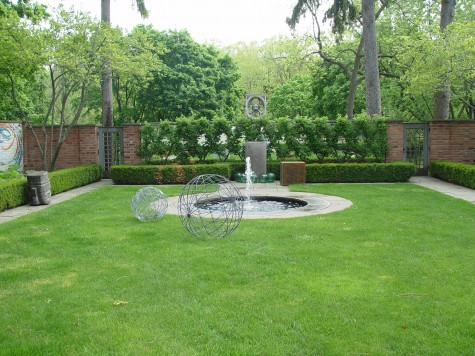 Some gates are part of a wall. The brick wall enclosing this garden permits a visit to the rear of the landscape; take your pick, which gate you wish to open. The pair of gates finishes each end of the long mirrored section of wall. A landscape beyond is clearly visible above the wall; the gates are an invitation to visit that space. The gates are wood, painted in a subtle color that does not detract in any way from the beauty of the walls.
Some gates are part of a wall. The brick wall enclosing this garden permits a visit to the rear of the landscape; take your pick, which gate you wish to open. The pair of gates finishes each end of the long mirrored section of wall. A landscape beyond is clearly visible above the wall; the gates are an invitation to visit that space. The gates are wood, painted in a subtle color that does not detract in any way from the beauty of the walls.
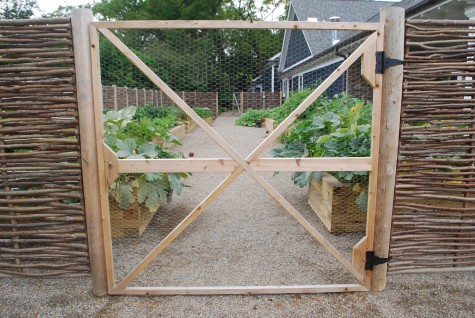 Vegetable gardens in my zone need to be fenced. We have woodchucks, rabbits, and deer for starters. The gate here-an exact replica of my client’s father’s vegetable garden in Italy. A simple pine frame with a crossbar and an X covered in galvanized chicken wire seems completely appropriate to the feel and the function of the space. The simple hand forged gate hardware-beautiful. This garden gate is designed to make good on its promise to keep out furry trouble.
Vegetable gardens in my zone need to be fenced. We have woodchucks, rabbits, and deer for starters. The gate here-an exact replica of my client’s father’s vegetable garden in Italy. A simple pine frame with a crossbar and an X covered in galvanized chicken wire seems completely appropriate to the feel and the function of the space. The simple hand forged gate hardware-beautiful. This garden gate is designed to make good on its promise to keep out furry trouble.
 Gating an arched space can be handled in a number of ways. This gateway has a fixed panel of ornamental iron at the top. The gates are tall rectangles that cleanly meet that pediment. These gates separate the rear yard from the pool yard. These gates are beautifully forged, yet easy to see through. A gate left open is inviting.
Gating an arched space can be handled in a number of ways. This gateway has a fixed panel of ornamental iron at the top. The gates are tall rectangles that cleanly meet that pediment. These gates separate the rear yard from the pool yard. These gates are beautifully forged, yet easy to see through. A gate left open is inviting.
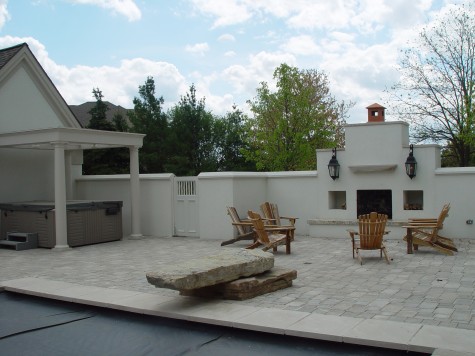 Some walls ask for a gate that is barely visible. Why is this? This gate goes to a place not nearly so dramatic a place to be as this pool deck. Some gates are about utility, and function. Subtle gates make passage possible, without disturbing any of the visual experience of the space.
Some walls ask for a gate that is barely visible. Why is this? This gate goes to a place not nearly so dramatic a place to be as this pool deck. Some gates are about utility, and function. Subtle gates make passage possible, without disturbing any of the visual experience of the space.
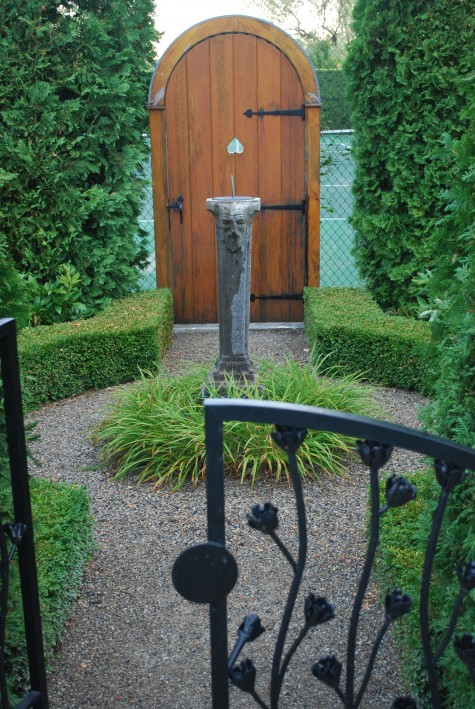 This solid wood gate has the look of an interior door. That solid surface screens the space beyond, and provides a beautiful backdrop for a small antique sundial. Once the arborvitae grow in, the tall chain link utility fence will no longer be visible. The gravelled space in the foreground functions much like a foyer in a home.
This solid wood gate has the look of an interior door. That solid surface screens the space beyond, and provides a beautiful backdrop for a small antique sundial. Once the arborvitae grow in, the tall chain link utility fence will no longer be visible. The gravelled space in the foreground functions much like a foyer in a home.
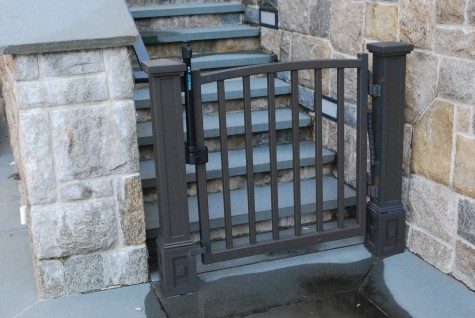 Some gates have a specific purpose. This gate may not be gorgeous, but it is child proof. Some gates are more about safety, than beauty. Clients with small children need to restrict certain spaces-in this case, a swimming pool. Once the children are old enough, the gate can be removed.
Some gates have a specific purpose. This gate may not be gorgeous, but it is child proof. Some gates are more about safety, than beauty. Clients with small children need to restrict certain spaces-in this case, a swimming pool. Once the children are old enough, the gate can be removed.
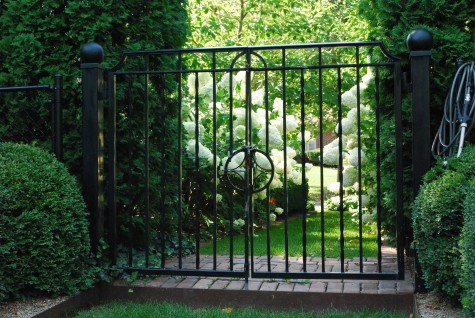
My gates and fence keep kids out of my yard. I have no objection to kids in my yard, but my fountain could be a hazard. Both gates into the yard are kept locked. They also keep my corgis on the property, and out of the street. The open ironwork preserves the view out, and the view in from the sidewalk; there is no need to block the view, just the passage. These gates replicate a pair of iron panels outside the front porch. They do a graceful job of making a space both private and safe.
i love garden gates. there is so much room for expression and art and a little mystery in them…they are the foreshadowing of a garden.
that heavy wooden gate with the upside down heart peep hole makes my heart pound!